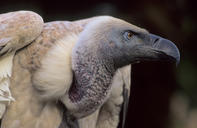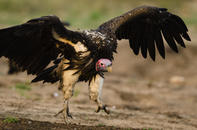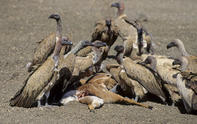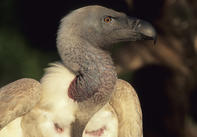A Ruff Scarf

Because of their naked heads and necks, vultures need to have a mechanism to control their temperature as heat exchanges easier through naked skin than through the insulation of feathers.
When they are circling kilometres up in the sky, ambient temperatures are cold. For this reason, they have an erectable ring of feathers around the base of the neck called a ruff.
The ruff acts like a scarf. Vultures also pull their necks into their bodies when in flight to prevent heat loss. The naked skin is useful for dissipating heat when on the ground on hot days.
Flat Feet

Vultures have flat feet and their claws are less curved than those of eagles who rely on their talons to hunt. This is because vultures spend a great deal of time on the ground and they would battle to take the mandatory run-up necessary to take off if their talons were more curved.
Vultures generally perch on prominent, sturdy perches like the dead anatomies of Leadwood trees. Being heavy birds, they require both a solid place to land and a convenient drop-off from which to gain leverage when taking to flight. At night when there are no thermals to facilitate flight, vultures roost in the large trees that typically line river courses.
Banked Food

The crop is a distensible storage ‘sock’ in front of the oesophagus. Since vultures are scavengers and their food supply is not guaranteed on a daily basis, they have developed the ability to fill their crops in a very short time (about two minutes) with up to 1.4 kg of carrion.
This food remains undigested while in storage. If vultures are unduly disturbed or threatened, they will regurgitate their crop-load, the evacuation of the putrid meat both lightens the bird so it can escape easily, and acts as a deterrent to the predator. A vulture can lose out on a whole ‘banked’ meal if it is forced to take this course of action.
Excellent Eyesight

Vultures have excellent eyesight. Some sources state that they can see a 6 cm object from 1 km up in the sky. This makes their eyesight eight times better than humans. It is not clear how this could be tested but what is clear is that they are exceptionally astute at spotting even small kills from high altitudes.
A vulture’s eyes have 2 lenses: one to see the broader landscape like a fisheye lens and one to magnify objects. Their eyes are large relative to the size of their skulls and bodies and this allows a bigger image to form on the retina thus providing more detail. Vultures have strong bills that are adapted to tearing tough flesh.
They are curved, have a fingernail texture and grow throughout life. In conjunction with this efficient tool, vultures also have serrated, rough tongues for prying smaller bits of meat off carcasses and bones.
By Megan Emmett